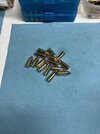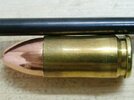Bullet pull is measured with an instrumented bullet puller. Mostly a mil-spec, the requirement is pretty high. I don't think the commercial manufacturers bother, too many reports of setback of factory loads.
Whacks with an inertia puller is a rough measure. I had a duff round to pull the other day and it did not take a lot, but more than required to separate one that had set back.
I think pushing the bullet against the bench edge tells the reloader where he is.
Perhaps the constriction contributes, I have a die that puts a cannelure in a 45 case at the base of the bullet, like a few factory loads still do. That sucker is not setting back.



